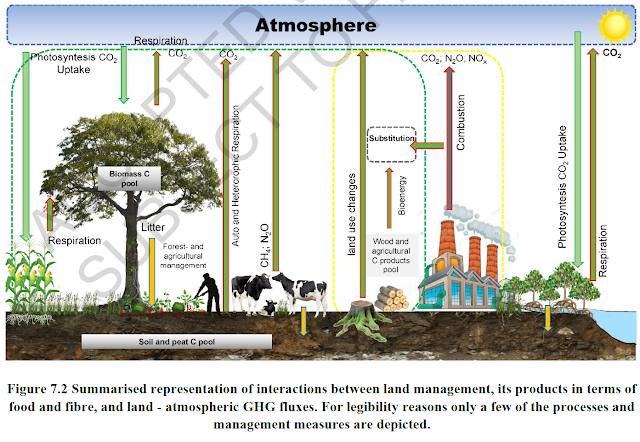These three designations: agriculture, forestry, and other land uses (AFOLU): refer to managed ecosystems, and they have the potential to significantly lower global warming. Focusing strictly on carbon dioxide, the land itself is a net carbon sink, but the industries accounted for about 5.9 ± 4.1 GtCO2 yr-1, anywhere from 13-21% of total global emissions. Managed forests and farms are estimated to absorb 12.5 ± 3.2 GtCO2 yr-1, leaving a net negative of 6.6 ± 5.2 (yes, that is a very large uncertainty) GtCO2 yr-1.
All illustrations from the IPCC 6th Assessment Report, Vol. 3, Chap. 7. Managed land use and the carbon cycle.
Global Agriculture, Forestry, and Other Land Use (AFOLU) CO2 flux.
The bulk of land-use change emission (45%) comes from deforestation. In recent years the rate of deforestation has decreased, but is far from stopping, and information is not always reliable (such as from Russia’s eastern taiga). Emission of other greenhouse gases are primarily of CH4 (4.2 ± 1.3 GtCO2eq-yr-1) from ruminants (cattle and other livestock), and NO2 (1.8 ± 1.1 GtCO2eq-yr-1) from the application of fertilizers and manure. But land-use change has not been uniform around the globe, with net loss occurring in the tropics and net gains, where they happen, regionally in the subtropical and sub-arctic regions of the north.
Global and regional trends in AFOLU CO2 flux.
AFOLU-related CH4 and NO2 flux.
It is estimated that the AFOLU sector can provide 25-30% of the emissions mitigation necessary by 2050 to achieve 1.5°C/2.7°F warming. The largest part of this would be through restoring forests, wetlands, peatlands and grasslands: expanding the organic carbon sinks, essentially, as easily the most efficient form of carbon capture we have. An average of models shows these methods reducing emissions by 7.3 (3.9-13.3) GtCO2eq-yr-1. (The confidence interval is uneven because the distribution of model results is skewed, and does not follow the bell curve.) The second major sphere of reductions will be from agriculture. More sustainable cultivation methods and adjusting the diet of livestock (to limit methane emissions) could reduce emissions by 4.1 (1.7-6.7) GtCO2eq-yr-1. Demand-side changes, including behavioral changes such as healthier, more sustainable (i.e. less beef and fat) diets and building with more wood and less metal and concrete, could reduce emissions by 2.2 (1.1-3.6) GtCO2eq-yr-1.
Regional AFOLU GHG fluxes.
Regional mitigation by greenhouse gas needed by 2050 and 2100 for four warming scenarios (1 . 5°C, 2°C, 3°C and 4°C).
Regional mitigation needed by type of use by 2050 and2100 for four warming scenarios (1 . 5°C, 2°C, 3°C and 4°C).
Tomorrow: urban systems and other settlements.
Be brave, be steadfast, and be well.












No comments:
Post a Comment